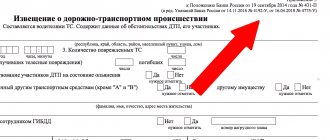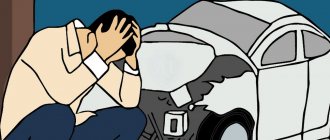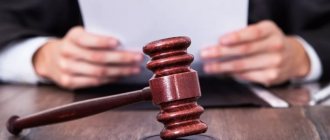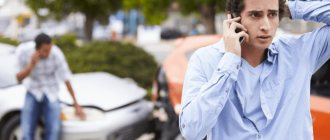First actions after an accident
Often, after an accident, due to stress, car owners begin to emotionally figure out which one is to blame.
Such proceedings often lead to conflicts and subsequent violations of the procedure for registering an accident. In order to comply with the established standards, every driver, regardless of the degree of guilt, must remember what is unacceptable to do after an accident:
- try to avoid responsibility by fleeing the scene of the incident;
- move cars until the arrival of the traffic police or video recording;
- stir up a conflict with the driver of the second car;
- engage in registration of an accident without checking the safety and absence of injuries of other participants in the incident.
Correct actions in case of an accident under compulsory motor liability insurance in 2021:
- safety assessment, detection of injuries in all citizens who were in damaged cars;
- If injured people are found, immediately call an ambulance team;
- placing signs warning other drivers that the road is closed as a result of an accident;
- Carrying out photo and video recording of the location of the damaged cars and the damage that appeared after the collision;
- exchange of contact information with the second driver (phone number and policy number);
- calling traffic police officers or mutual agreement to the European protocol;
- if you disagree with the information about the accident presented in the police description of the accident, make a corresponding note in the field provided for this;
- receive from the state traffic inspector one copy of the protocol, police confirmation of the fact of the accident and a document on traffic violation;
- contact the company where the contract was concluded and report the current situation.
It is necessary to call a company employee to the scene of an accident if this clause is marked as mandatory in the contract.
If the damaged cars create a significant obstacle that completely blocks the flow of other cars, detailed photos and videos should be taken from different angles, recording the position of the cars and individual damage. After this, you should drive the cars to the side of the road and make way for other cars.
What should you not do in case of an accident?
Rules to follow at the scene of an accident:
- do not be nervous. This recommendation is difficult to implement, but it’s worth trying;
- forget about aggressiveness towards other participants in the accident. A fight with the person responsible for the accident will lead to only one thing - a statement to the police and new problems;
- Don't act hastily. Think before you move or put anything away. During the trial, every little detail matters;
- don't get lost. The ability to prove innocence or reduce the level of punishment (if there is still guilt) depends on literacy and clarity of actions.
Above we discussed in general terms what to do in the event of an accident. Now let's take a closer look at each of the points:
Stopping the car
Despite the simplicity of the recommendation (which is easier than stopping), there are nuances. After arriving at the scene of the incident, traffic police officers measure the distances between the vehicle and other objects. This means that you need to stop immediately, and not after 70-100 meters on the side of the road.
Turning on the emergency lights does not cause any problems, but many do not remember the distance at which the sign must be placed. If the accident occurred in a populated area, then the distance from the car to the sign is 15 meters or more. If the trouble occurred outside the city, then from 30 meters.
Installation of the sign is required. This is done not only for the inspector, but also for your own safety. Other road users must see that there is danger ahead and that they need to slow down. One of the main problems is the exact location of the sign. So, at an intersection it is not clear which side he should stand on. Make your decision after analyzing and choosing a potentially dangerous direction.
Important Items
People who are faced with problems face to face for the first time and do not know what to do in case of an accident do not pay attention to the little things. This is mistake. When analyzing the situation, even the smallest nuances are taken into account - elements of the car that lie at the scene of the accident, the length of the braking distance, objects flying out of the luggage compartment, and so on. Road conditions are no less important - the presence of ice, puddles, potholes, visibility in a given area, installation of signs, and so on. Make sure that the points described are reflected in the inspector’s report.
Calling an ambulance
If you don’t have enough knowledge to provide personal assistance, then you shouldn’t take risks - you should entrust the work to doctors. By being overzealous, you risk making things worse.
Witnesses
Ask an experienced car enthusiast what to do if you get into an accident. He will definitely answer - “record the testimony of eyewitnesses.” In the event of an accident, it is witnesses who help restore an accurate picture of events and help inspectors understand the accident.
Calling the traffic police
By law, every accident must be recorded. It is possible to resolve the issue without involving traffic police officers in the event of minor damage to the vehicle, the consent of the parties and the absence of victims. But there are three points to consider here:
- without registration it is difficult to count on compensation from the insurer;
- the process of covering damage becomes more complicated;
- the law is broken. If you leave the scene of the incident, there is a “chance” of getting up to 15 days of arrest or being left without a license for 1-1.5 years.
Compensation for damage in case of an accident under compulsory motor liability insurance
Expenses associated with repairing a damaged vehicle are compensated by a company representing the guilty party. To do this, specialists check the damage and assess the damage. The injured party has the right to seek payment of the missing amount through the court if there is confidence in the understatement of the amount of payments.
Payments under compulsory motor liability insurance in case of an accident when both drivers have a policy
This is the simplest option to resolve the issue. Participants in an accident simply need to provide the company’s employees with a set set of documents and submit an application for payment.
When using the European protocol, 5 days are allotted for delivery of papers. Under any circumstances, the sooner the car owner notifies the insurance company about the incident, the easier the settlement procedure with the company.
What to do if one of the drivers does not have a valid policy
For minor damage, it is better to try to negotiate compensation for the damage on the spot.
The injured party, even in the absence of a contract, still receives compensation from the culprit’s insurer. The only difficulty may be the location of the company where the car owner entered into the contract. Sometimes the victim has to contact an office located in another city or region. When both drivers have insurance, these nuances are decided between the companies themselves.
The injured driver will have to pay a fine for driving without a license.
If the culprit does not have insurance, it will be more difficult to obtain compensation. In the most acceptable option, the car owner who provoked the situation pays for the damage on the spot. In other cases, you will have to call the traffic police and seek payment through the courts.
What documents are required for payment under compulsory motor liability insurance in case of an accident?
The list of documents depends on the circumstances of the accident. The main set includes:
- application for payment for restoration work;
- passport;
- driver's license;
- confirmation of car ownership or driving rights;
- protocol written by the inspector or European protocol;
- vehicle registration certificate;
- STS;
- notification of an incident;
- a valid insurance contract;
- details for transferring funds.
If necessary, the list is supplemented:
- report on the examination carried out;
- receipts and checks for payment for the tow truck, expert and related expenses;
- medical report on injuries or disability;
- an extract from the medical history;
- documents confirming expenses for treatment;
- certificate of dependents.
- death certificate;
- confirmation of funeral expenses.
Cash payment or repair - which is preferable?
If an insured event occurs due to an accident under compulsory motor liability insurance, a more profitable option for the owner is to have the car repaired at a service station owned by the insurance company. When determining the amount of payments, they rely on wear and tear of parts and other indicators that reduce the value of the car. The amount received may be much lower than what is needed to completely repair the damage to the car.
When carrying out repairs by the insurance technician, they are required to replace all damaged parts with new ones, regardless of their degree of wear. If hidden defects are identified, the company is also obliged to pay for their elimination.
Read more in our article: money or repairs under MTPL?
Reasons for refusal of payments
Several situations have been identified in which the insurance company has the right to refuse compensation payments. These include:
- providing an expired or counterfeit policy;
- filing an application under a policy in which the victim is not included as a person admitted to management;
- the accident occurred as a result of the transportation of dangerous goods;
- an application for compensation for moral damage has been filed;
- the required set of documents has not been provided;
- the accident was staged to obtain insurance payments;
- the application specifies compensation for damaged luxury items (antiques, precious jewelry, expensive household appliances);
- the culprit of the accident has not been identified;
- the application was submitted 2 years after the occurrence of the insured event;
- the application does not contain details for transferring compensation;
- the information in the application is incomplete or untrue.
Director Nikolay Kolyada
On July 10, 2021, playwright and theater director Nikolai Kolyada was involved in an accident in Yekaterinburg. Kolyada was driving a Renault Duster. When changing lanes to the left, he did not pay attention to a Hyundai Santa Fe moving in his lane and collided with it. The driver of the Hyundai was seriously injured as a result of the accident. On September 19, 2021, the Kirovsky District Court of Yekaterinburg found Kolyada guilty of violating traffic rules and causing grievous bodily harm through negligence (Part 1 of Article 264 of the Criminal Code of the Russian Federation). The director was sentenced to restriction of freedom for a period of one year and six months without deprivation of his driver's license. The civil claim of the victim was also partially satisfied, in whose favor 200 thousand rubles were recovered from Kolyada. On November 13 of the same year, the Sverdlovsk Regional Court upheld the verdict.
How to receive payments under compulsory motor liability insurance after an accident if the culprit does not admit his guilt
Those responsible for the accident often refuse to admit their guilt. This is due to the fact that the insurance company pays compensation only to the injured party. The driver who created the emergency will have to restore his car himself.
In such cases, it is better for the victim to use the help of a car lawyer, since the case can last for several months and will require drawing up a statement of claim. If the person responsible for the accident refuses to admit his guilt, the victim must adhere to the correct line of behavior:
- do not allow anyone to make changes to the picture of the incident;
- carefully record in a photo or video the position of the cars, marks on the road and damage received;
- call traffic police to the scene of the accident;
- collect contact information of witnesses to the accident;
- ensure that the necessary data is entered into the protocol in full;
- call an insurance employee to the place;
- file a claim in court.
Often, the culprit of the accident refuses the previously admitted guilt after the European protocol has been drawn up, and goes to court to challenge it. In such situations, the victim will have to prove his case by providing the judge with all the photos and video materials, the protocol in hand, the expert report and other documents.
You should not agree to the proposal to wait two months (when it is too late to draw up a protocol on an administrative violation) and reach an amicable agreement. In such a situation, the victim loses valuable time. The insurance company insists on providing documents according to the European protocol within 5 days, or 15 days with a call from the traffic police.
Although these deadlines are not confirmed by law, a delay could complicate an already difficult situation.
Responsibilities of the driver in case of an accident In case of a road accident, the driver involved in it is obliged to perform the actions prescribed by the Traffic Rules (clause 2.5 of the Road Traffic Rules):
– immediately stop (do not move) the vehicle, turn on the hazard warning lights and display a warning triangle (flashing red light), do not move objects related to the incident; - take possible measures to provide pre-hospital medical assistance to the victims, call an ambulance, and in emergency cases, send the victims along the way, and if this is not possible, deliver them in your vehicle to the nearest medical facility, provide your last name, vehicle registration plate (with presentation of an identification document or driver's license and registration document for the vehicle) and return to the scene of the incident; clear the roadway if the movement of other vehicles is impossible. If it is necessary to clear the roadway or deliver victims in your vehicle to a medical facility, first record in the presence of witnesses the position of the vehicle, traces and objects related to the incident, and take all possible measures to preserve them and organize a detour to the scene of the incident; – report the incident to the police, write down the names and addresses of eyewitnesses and wait for the arrival of police officers. The case when one car was involved in an accident The requirements of the Rules also apply to those cases when only one car was involved in an accident, which was damaged due to the fault of its owner (for example, when leaving a garage), or when the owners discover their car damaged by an unidentified vehicle {for example, leaving it in the parking lot). And these are also road accidents that require calling a traffic police officer. The fact is that if such incidents are not registered with the traffic police, then any traffic police officer can subsequently stop the damaged car and, in the absence of an appropriate certificate confirming the fact of the accident, detain the driver to check the causes of the damage. An exception is when the Rules allow leaving the scene of an accident. If there are no injuries as a result of the accident, drivers, with mutual agreement in assessing the circumstances of the incident, can, having previously drawn up a diagram of the incident and signed it, arrive at the nearest road patrol service (DPS) post or police department to register incidents (clause 2.6 of the Traffic Rules). In any case, an accident report is required. You cannot drive away from the scene of an accident by mutual agreement of the parties. The traffic police certificate is, firstly, proof that your car was not the culprit of some other accident with more serious consequences, and secondly, the list of damage to the car recorded in the certificate will help you achieve compensation for damage, and also will not turn minor damage to the car of another participant in the accident into major damage that you must compensate. The time for the arrival of a traffic police officer at the scene of an accident is not regulated. When there are injuries as a result of an accident or several vehicles are involved, traffic police officers leave quite quickly. When minor accidents occur, the arrival of traffic police officers may require a longer wait. Not a single regulatory document, including departmental ones, sets a time limit for the arrival of a traffic police officer at the scene of an accident. Responsibility for leaving the scene of an accident Leaving the scene of an accident by a driver under certain conditions is recognized as a crime, and this act falls under the Criminal Code.
In other cases, the driver who left the scene of the accident is subject to administrative liability. If a driver left the scene of an accident in which he was subsequently found not guilty, he is subject only to administrative liability. The statute of limitations for administrative liability is currently set at 2 months. On topic: Criminal case regarding an accident











